-
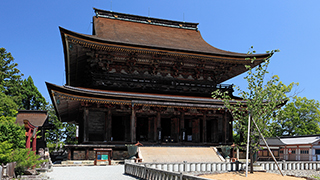
 Zaodo (Main Hall)
Zaodo (Main Hall)The main building of Kinpusenji Temple, the Zaodo, has been designated a National Treasure. It houses three huge statues of Zao Gongen (the principal object of worship for the Shugendo religion), which are only occasionally exhibited to the public. Visitors will find many other treasures within this impressive hall, the second-largest traditional wooden building in Japan after Todaiji Temple’s Great Buddha Hall in Nara.
Most of the massive supporting columns in the hall are not painted, and still show the natural knots and grain of the wood from trees such as pine and cedar.
According to legend, the founder of Shugendo, En no Gyoja (634–701), established the temple on this spot sometime during the seventh century. Zaodo burned down several times over the years. The current hall is still quite ancient, dating back to 1592.
Priests hold a daily fire ritual, known as goma, in which wooden prayer plaques (gomaki) are burned inside the hall. The ritual is held each morning and is open to the public. -
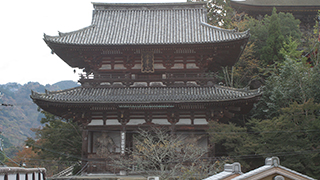
 Niomon Gate and Niozo Statues
Niomon Gate and Niozo StatuesKinpusenji Temple’s north-facing Niomon Gate is an imposing two-story structure over 20 meters in height. This National Treasure dates back to the turbulent Nanbokucho period (1336–1392) and is one of only a few original two-story gates still standing in Japan. It is the only remaining main gate at Kinpusenji, as the south-facing Nitenmon Gate burned down.
The 5-meter-tall Kongo Rikishi guardian statues on either side of the gate date back to the fourteenth century, and have been designated Important Cultural Properties.
The gate is currently undergoing preservation work for the first time since the 1950s, and may be covered until 2030. -
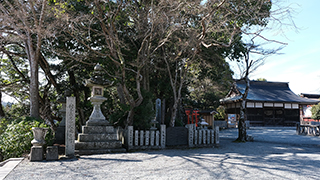
 Nitenmon Gate
Nitenmon GateNitenmon was Kinpusenji Temple’s main south gate until it burned down in 1341. The gate has not been rebuilt since then. Available historical records indicate that the gate had two stories, was roofed with tiles and painted red. It is associated with the heroic story of Murakami Yoshiteru, the loyal retainer of the fourteenth-century Prince Morinaga (1308–1335).
In Japan from the twelfth century, ruling power was in the hands of the warrior class, but in the early fourteenth century, Emperor Godaigo endeavored to return sovereign power to the court. To support this effort, Godaigo’s son Prince Morinaga and his retainers disguised themselves as yamabushi (practitioners of Shugendo) and went to Yoshinoyama to confront the forces of the warrior regime.
It was not long, however, until the prince’s troops were outnumbered by the warrior side and as defeat proved certain, Prince Morinaga resolved to commit suicide. Among his retainers, however, was the famously loyal Murakami Yoshiteru. Murakami climbed to the second floor of the Nitenmon Gate, disguised himself as the prince and performed ritual suicide there in front of the enemy. While the enemy was thus distracted, the prince and the rest of his retainers were able to escape, making their way toward Mt. Koya. Murakami’s self-sacrificing, heroic deed remains admired and retold to this day, and he is honored with a stone column located beside the spot where the Nitenmon Gate once stood. -
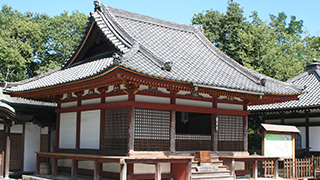
 Kannondo Hall
Kannondo HallThe principal image enshrined in the hall is a standing statue of the Eleven-Faced Kannon.
It is believed that the hall was built in around the Nanbokucho period (1336–1392) and Muromachi period (1336–1573).
According to legend, the principal image, or the standing statue of the Eleven-Faced Kannon, was created by the Northern and Southern Courts, and that the standing statues of Buddha’s disciples, Ananda and Kashyapa, at the side of the hall used to be housed at Sesonji Temple, which is currently in disuse. -
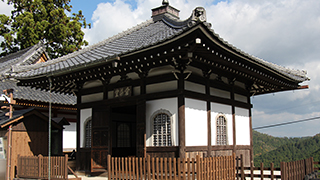
 Aizendo Hall
Aizendo HallThis small hall was built in 1770, and originally housed a collection of Buddhist scriptures. In 1983, it was rechristened as the Aizendo Hall, as it now enshrines the statue of a seated Aizen Myo-o. The statue dates back to the 1870s and once was venerated at the now-abandoned Anzenji Temple.
Aizen Myo-o is a protective Buddhist deity, whose role is to sublimate people’s earthly passions into a state of enlightenment. Besides the fulfillment of romantic love, Aizen Myo-o is also an important figure in the connection between people and even things.
During the Aizendo Festival held once a year on November 27, a large-scale gomataki fire ritual is performed before the Aizen Myo-o. Believers write their wishes and hopes on wooden prayer plaques called gomaki, which are then burned in front of the altar. -
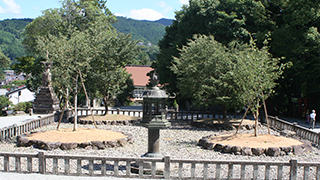
 Four Cherry Trees of Kinpusenji Temple
Four Cherry Trees of Kinpusenji TempleYoshinoyama has been a beloved cherry blossom viewing destination since the Heian period (794–1185), and many white-flowering trees are found within Kinpusenji Temple’s grounds.
This fenced area in front of the entrance to the Zaodo (main hall) contains four particularly important trees. In the skirmishes here between the forces loyal to the emperor and the army of the shogunate in 1333, it is believed that Prince Morinaga (1308–1335) held his final banquet at this spot, just before his palace fell to an attack by the enemy army of 60,000. These trees are a fitting tribute to the prince and his sad story. -
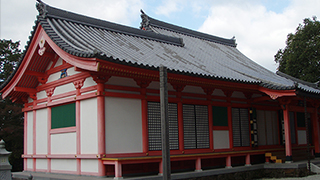
 Honchido
HonchidoThis modern building is tucked behind the larger Zaodo, Kinpusenji Temple’s main hall. It was built in 2000 to celebrate the 1,300-year anniversary of the death of En no Gyoja (634–701), the founder of the Shugendo religion.
Among the Buddhist figures enshrined in the hall is a Buddha triad: a Shaka Nyorai and two bodhisattvas—the Thousand-Armed Kannon and the Miroku (Maitreya), Buddha of the Future. These are the three deities who appeared to En no Gyoja in the form of Zao Gongen, whose images are enshrined within the Zaodo. There is also a statue of En no Gyoja, accompanied by Zenki and Goki, two demons he tamed while training in the Ikoma mountains. -
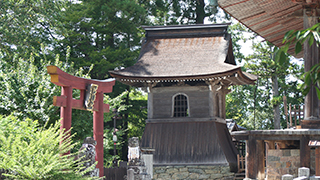
 Shorodo Bell Tower
Shorodo Bell TowerThe original date of construction of this bell tower is unknown, and the tower has been repeatedly burned down and reconstructed over the centuries. The current structure underwent major repairs in 1999, after being toppled by a typhoon the previous year.
Since the Edo period (1603–1868), the bells have sounded three times a day to announce the time and the beginning of memorial services. -

 Honbo
HonboThe honbo is located to the northwest of the Zaodo, or main hall. The current structure was built in 1924. For several decades, it was used to house the administration office of Kinpusenji Temple and as a place to receive honored guests.
The building, which is also called Chisenkaku, is an unusually fine example of modern Japanese architecture. -
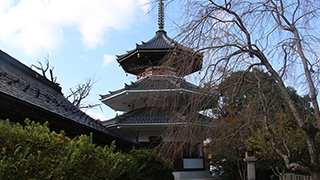
 Nancho Myohoden Hall
Nancho Myohoden HallKinpusenji Temple constructed this hall on the former site of the Yoshino Southern Imperial Palace in 1958. It was built to appease the souls of the four emperors who lived in Yoshino and those who served them, who lost their lives during the turbulent Nanbokucho period (1336–1392), as well as those lost during the Second World War. Every year on October 15, a rite is held to honor the souls of the emperors.
The principal image enshrined within the hall is a statue of Shaka Nyorai, the historical Buddha, which was once the principal image of Jitsujoji Temple, where the emperor at the time once resided. -
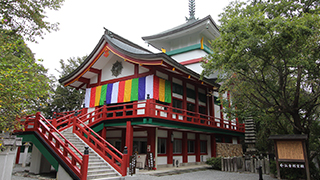
 Buddha Treasure Hall
Buddha Treasure HallThis hall was built to enshrine a piece of one of the Buddha’s bones. In 1967, Kinpusenji was the first temple in Japan to receive one of these holy relics as an official gift from the Indian government.
This great honor was bestowed on the temple because one of the manifestations of Zao Gongen, who appeared to Shugendo founder En no Gyoja (634–701), was the Buddha. -
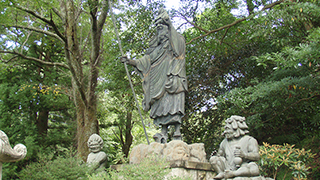
 Copper Statue of En no Gyoja
Copper Statue of En no GyojaThis standing statue was created in 1951 in honor of the 1,250-year anniversary of En no Gyoja’s death, and is an unusual depiction of the founder of the Shugendo religion. While most sculptures of En no Gyoja show him sitting on a rock, in a rather powerful demeanor, here he is depicted standing and looking straight ahead.
En no Gyoja was born in 634 in the Gose area of Nara, according to the Nihon ryoiki chronicle. From childhood, he was fascinated by mountains, and started training in the forest slopes of Mt. Katsuragi. Devoting himself to asceticism, he spent his life traveling extensively, climbing sacred mountains, and establishing Shugendo sanctuaries throughout the country. These include Kinpusenji Temple and Ominesanji Temple on Mt. Omine.
There are many legends about En no Gyoja. One has him sitting with his mother in an iron alms bowl, placing it on a five-colored cloud, and ascending with her to heaven. Another tells how he captured and tamed two demons (oni) called Zenki and Goki, who thereafter served him and did his bidding. In most depictions of En no Gyoja, he is flanked by the two oni. -
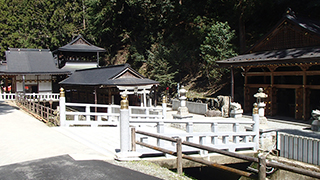
 Noten Daijin Ryuoin Temple
Noten Daijin Ryuoin TempleThis temple sits above a rushing river at the bottom of a deep valley, down a long, lantern-lined stone stairway leading from Kinpusenji Temple.
According to legend, when the high priest of Kinpusenji Temple started to build a training dojo on this spot, he came across a dead snake with its head split open. Feeling compassion for the creature, he recited a sutra and respectfully buried it. After that, the snake repeatedly appeared in his dreams, thanking him for the kind act. The priest eventually realized that the snake was a manifestation of the Zao Gongen images enshrined in Kinpusenji Temple’s main hall, the Zaodo.
The temple is named after Noten Daijin, the protector of everything related to the head and brain, the seat of all human thought. Many visitors come to pray for relief from headaches and other head-related complaints, and students come to pray for success in their schoolwork. The temple even holds special prayer sessions from mid-January to late February for students preparing for entrance exams. The present building dates from 1951. -
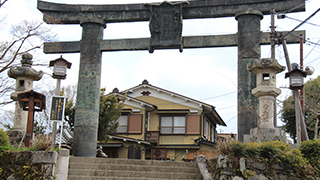
 Kane no Torii
Kane no ToriiKane no Torii is about 200m north of Niomon Gate.
This copper torii gate is the first of four important torii gates that Shugendo practitioners must pass as they seek enlightenment on the challenging path to sacred Mt. Sanjogatake.
This first gate is the hosshinomon, or gate of spiritual awakening. Passing through the gates signals the beginning of training for Shugendo practitioners.
While torii gates are usually associated with shrines, the pillars stand on two lotus daises, showing that it belongs to a Buddhist temple.
According to legend, the original gate was made using leftover copper from the creation of the massive Great Buddha statue housed inside Todaiji Temple, in nearby Nara. The current gate is a reconstruction dating from the Muromachi period (1336–1573).
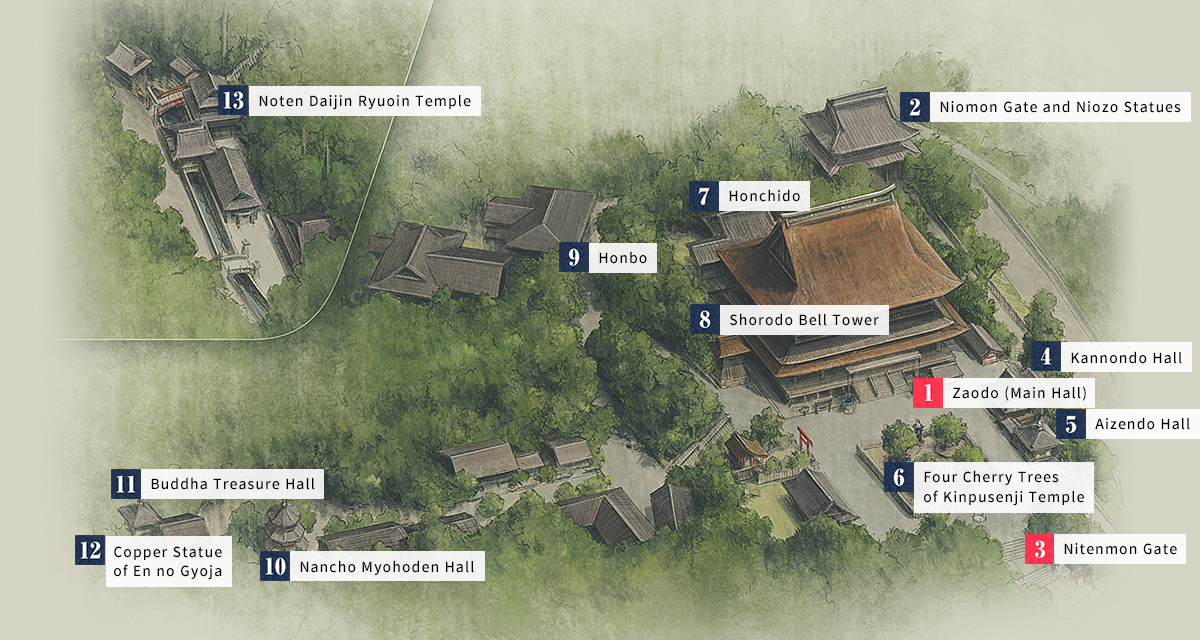

![]() is the position where you read the sign.
is the position where you read the sign.
